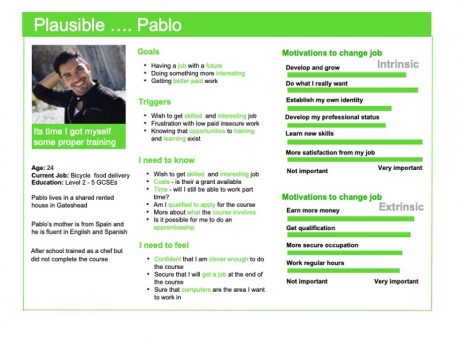3.4 Case Study: Learner Support – CiCi Chatbot
We live in an age of conversations often powered by artificial intelligence (AI) and machine learning. This may take the form of scripted customer service chatbots embedded in online banking or insurance systems, to non-scripted chatbots that help inform and support individuals’ health, well-being and other specific needs. New conversational interfaces are becoming part of our everyday lives. Chatbots are increasingly being used in education to pride support for learning
In England in 2020, NESTA – an innovation foundation – and the Department of Education (DfE) set a national ‘CareerTech Challenge’ through a prize competition on innovative uses or sources of Labour Market Information to improve careers information, advice and/or guidance.
CiCi – the powerhouse that supports your career – one of twenty national finalists – has been co-designed alongside professionally trained careers and employability advisers, careers support services, understanding how best to use open datasets in this context, capturing new and evolving labour market trends and new forms of career trajectories. The chatbot is designed particularly for adults either unemployed or wanting to change jobs and to learn new skills, especially in vocational education and training.
Deidre Hughes, who leads the CiCi project says: “The impact of Covid-19 has resulted in rising levels of inequality with lowest earners more likely to have been affected by the pandemic than those on the highest salaries.. There is a growing need to increase efforts in promoting learning and work opportunities. Individuals need easy access to trustworthy careers information, advice and guidance, particularly in volatile, uncertain and complex labour markets.”

She goes on to say “Digital technologies are deeply intertwined with human activities. We believe humans and bots can potentially work well together. New technology creates online spaces and places for constant interaction between humans and non-humans. The use of big open datasets has significant potential, including use of national and local labour market trends, salaries and job prospects.”
A well designed chatbot system can respond to repetitive and typical questions and can improve the efficiency of a careers or employability service in freeing up time for practitioners to focus on more in-depth support for their clients. The chatbot uses Artificial Intelligence and Natural Language Processing to translate bite-sized careers information and advice to adults in English cities accessible throughout the day and night. The chatbot can be accessed on computers and mobile devices and can be embedded into web portals and social media. Designed to be flexible and agile, the software behind CiCi is modular allowing for rapid adaption and updating.
A key issue is how chatbots can be used by teachers, trainers and other education professionals Deirdre Hughes explains: “The ongoing development is testing the boundaries between online careers information and advice and professional career guidance, delivered by qualified careers and employability specialists. In particular, can the bot be trained using AI to learn its own limitations and to know when to refer the user to a careers’ professional? With permission granted by the client, can chatbot share information in advance of a careers interview, so that the person does not have to repeat what they have done already in their career search? CiCi provides reassurance to the individual user of professional support available locally, if needed. The chatbot also enables practitioners to have an added tool to work effectively with their clients and concentrate their specialist skills on those most in need.’
Finally, Deirdre Hughes believes “Professionalisation of the workforce must include finding ways of co-designing and using chatbots and adding this to the practitioners’ expert repertoire of support services. Chatbots hold great promise for organisations, professionals and their clients/customers. Now is an exciting time for practitioners, programmers and organisations to engage and stay ahead of the innovation curve.”
Activity
Try out the working demonstration of the CICi chatbot: https://careerchat.uk/
Think how this might help adults looking for new jobs or vocational education and training courses
Questions for reflection
CiCi has been designed for careers support. What other areas do you think Chatbots could be used for in vocational education and training?
How do you think Chatbots could support vocational learners?
Do you think that AI-based applications like chatbots can work effectively alongside teachers and trainers and other education professionals? What might be barriers to this?
More reading:
ETF (2020). Innovation in career guidance. International trends and case studies in the European Union, internationally, and in selected partner countries. European Training Foundation. https://www.etf.europa.eu/sites/default/files/202011/innovation_in_career_guidance_vol._1.pdf
Joyce, R. & Xu, X. (2020). Sector shutdowns during the coronavirus crisis: which workers are most exposed, London: Institute for Fiscal Studies, April 2020 – https://www.ifs.org.uk/publications/14791
Attwell, G., & Hughes, D. (2019). Aprendizaje sobre carreras: datos abiertos e inteligencia del mercado laboral. RIED. Revista Iberoamericana de Educación a Distancia, 22(1). doi:10.5944/ried.22.1.22289
Arthur, M. (2021). Building a Bot to Beat the Bots: An Award Winning Approach from Across the Pond, Forbes.com, March 2021 – https://www.forbes.com/sites/michaelbarthur/2021/03/29/building-a-bot-to-beat-the-bots-an-award-winning-approach-from-across-the-pond/?sh=6d8a8e252a6a
Řihová, H. (2016). Using Labour Market Information: Guide to anticipating and matching skills and jobs, Vol. 1, European Training Foundation, Cedefop and ILO – https://www.etf.europa.eu/sites/default/files/m/72994A6E29422658C125810800318A04_Vol.%201%20Using%20labour%20market%20information.pdf
